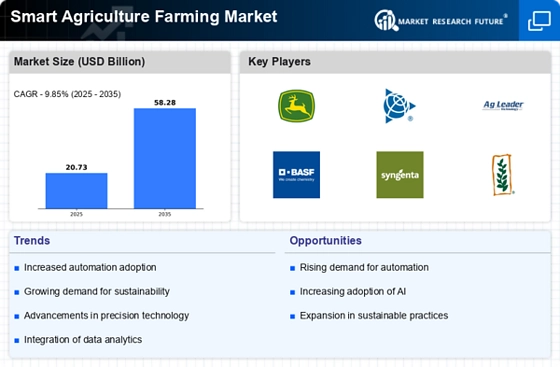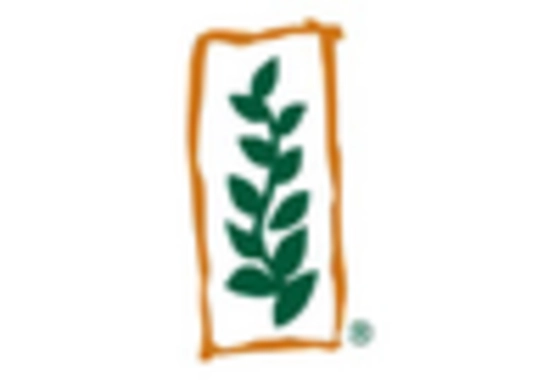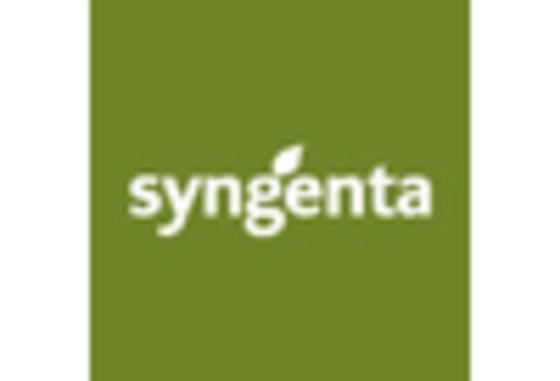Rising Demand for Food Security
The Smart Agriculture Farming Market is significantly influenced by the rising demand for food security. As the global population continues to expand, the pressure on agricultural systems to produce sufficient food increases. This demand compels farmers to adopt innovative practices that enhance productivity while minimizing environmental impact. Reports suggest that by 2050, food production must increase by approximately 70% to meet the needs of the projected population. Consequently, smart agriculture solutions, which leverage data analytics and automation, are becoming essential tools for farmers. These solutions not only help in maximizing yield but also in ensuring sustainable practices, thereby addressing the critical issue of food security within the Smart Agriculture Farming Market.
Government Initiatives and Support
Government initiatives and support play a crucial role in the Smart Agriculture Farming Market. Many governments are recognizing the importance of modernizing agricultural practices to enhance productivity and sustainability. Various programs and subsidies are being introduced to encourage farmers to adopt smart farming technologies. For instance, funding for research and development in agricultural technologies is on the rise, with some countries allocating significant budgets to support innovation in this sector. This governmental backing is likely to accelerate the adoption of smart agriculture solutions, as farmers are incentivized to integrate advanced technologies into their operations. Such initiatives are expected to drive growth in the Smart Agriculture Farming Market.
Environmental Sustainability Concerns
Environmental sustainability concerns are increasingly shaping the Smart Agriculture Farming Market. As awareness of climate change and resource depletion grows, there is a pressing need for agricultural practices that minimize environmental impact. Smart agriculture technologies, such as precision irrigation and soil health monitoring, are designed to optimize resource use and reduce waste. Data indicates that implementing these technologies can lead to a reduction in water usage by up to 30%, which is critical in regions facing water scarcity. This focus on sustainability not only addresses environmental challenges but also appeals to consumers who are increasingly favoring sustainably produced food. Thus, the emphasis on environmental sustainability is likely to propel the Smart Agriculture Farming Market forward.
Technological Advancements in Agriculture
The Smart Agriculture Farming Market is experiencing a surge in technological advancements that enhance farming efficiency and productivity. Innovations such as drones, autonomous tractors, and advanced sensors are becoming increasingly prevalent. These technologies enable farmers to monitor crop health, optimize resource usage, and improve yield. According to recent data, the adoption of precision agriculture technologies is projected to grow at a compound annual growth rate of over 12% in the coming years. This trend indicates a strong shift towards data-driven farming practices, which are essential for meeting the demands of a growing population. As these technologies become more accessible, they are likely to play a pivotal role in shaping the future of the Smart Agriculture Farming Market.
Increased Investment in Agricultural Technology
The Smart Agriculture Farming Market is witnessing increased investment in agricultural technology, which is driving innovation and growth. Venture capital and private equity firms are increasingly funding startups that focus on smart farming solutions. This influx of capital is fostering the development of new technologies, such as artificial intelligence and machine learning applications in agriculture. Recent statistics indicate that investment in agri-tech has surged, with billions of dollars being funneled into research and development. This trend suggests a robust interest in enhancing agricultural productivity through technology. As these investments continue to grow, they are likely to lead to breakthroughs that will further transform the Smart Agriculture Farming Market.


















Leave a Comment